Safe Work Practices for Direct Client Care - Assessment Task
VerifiedAdded on 2023/01/13
|21
|3803
|1
Homework Assignment
AI Summary
This assignment delves into the critical aspects of safe work practices within direct client care settings. It begins by addressing WHS legislation, exploring the roles and responsibilities of state/territory authorities, employers, and workers. The assignment then defines hazards and identifies common workplace risks, including hazardous manual tasks, infection control, and personal safety. It emphasizes the significance of WHS policies and procedures, offering ways to contribute to their development and implementation. The document also covers maintaining currency on safe work practices, interpreting safety signs, and recognizing the impact of stress and fatigue on worker safety, including reporting procedures. Finally, a case study examines infection control in a home visit scenario, analyzing the source of infection, risks, client responsibilities, and standard precautions. The assignment provides a comprehensive overview of essential safety protocols in the healthcare environment.
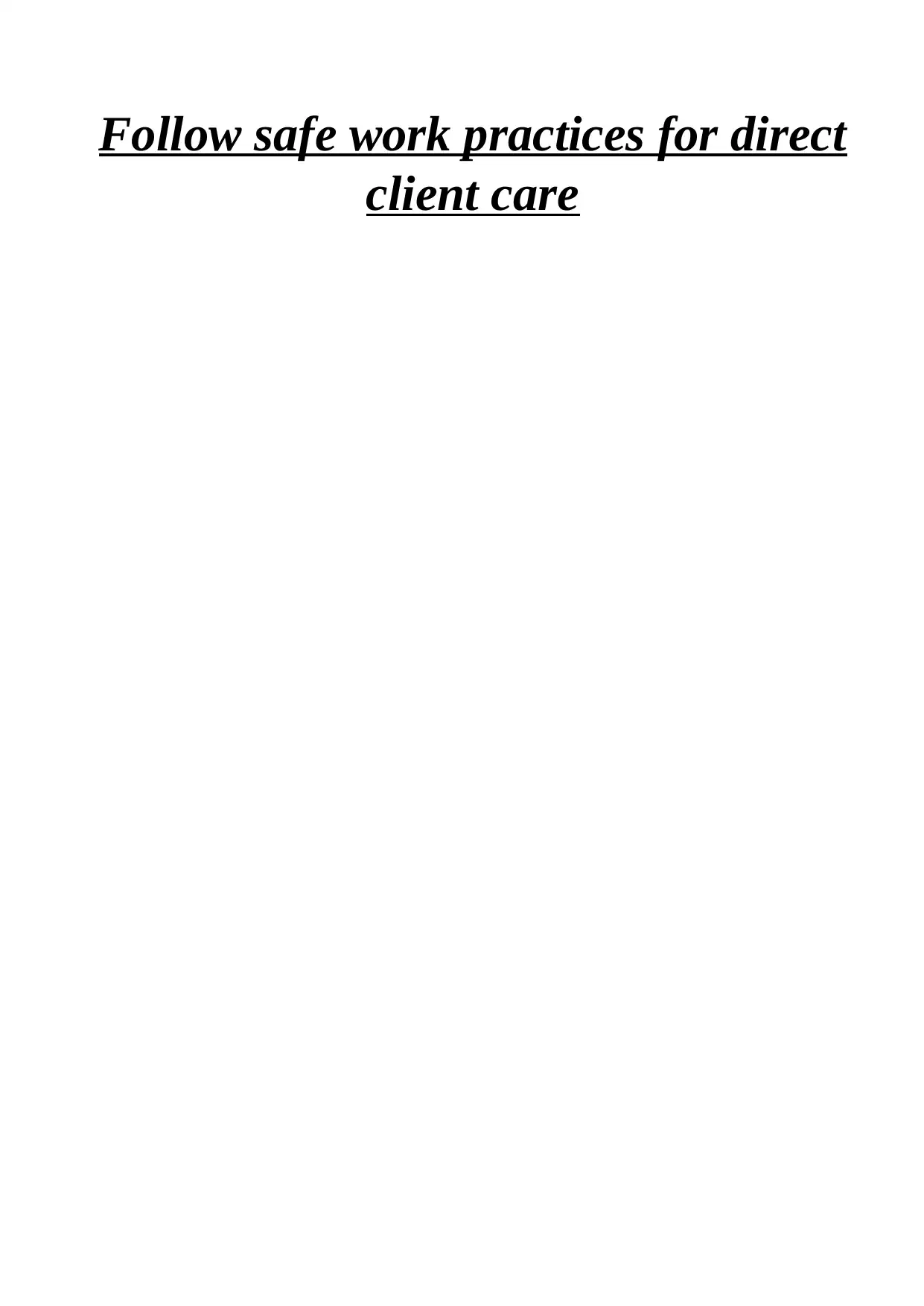
Follow safe work practices for direct
client care
client care
Paraphrase This Document
Need a fresh take? Get an instant paraphrase of this document with our AI Paraphraser

Table of Contents
1.ASSESSMENT TASK 1 – Short answer questions...................................................3
2.TASK 2................................................................................................................16
1.ASSESSMENT TASK 1 – Short answer questions...................................................3
2.TASK 2................................................................................................................16
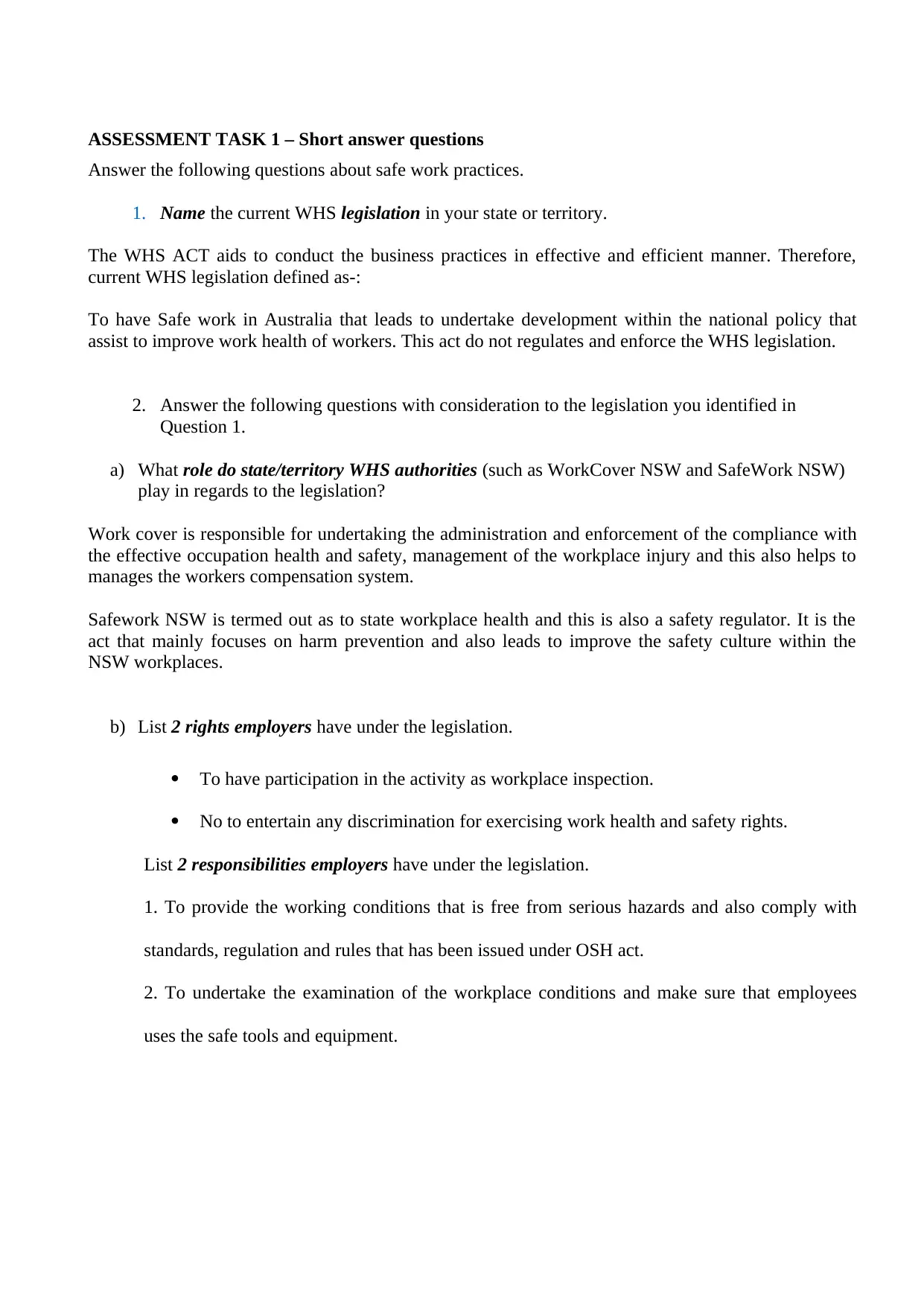
ASSESSMENT TASK 1 – Short answer questions
Answer the following questions about safe work practices.
1. Name the current WHS legislation in your state or territory.
The WHS ACT aids to conduct the business practices in effective and efficient manner. Therefore,
current WHS legislation defined as-:
To have Safe work in Australia that leads to undertake development within the national policy that
assist to improve work health of workers. This act do not regulates and enforce the WHS legislation.
2. Answer the following questions with consideration to the legislation you identified in
Question 1.
a) What role do state/territory WHS authorities (such as WorkCover NSW and SafeWork NSW)
play in regards to the legislation?
Work cover is responsible for undertaking the administration and enforcement of the compliance with
the effective occupation health and safety, management of the workplace injury and this also helps to
manages the workers compensation system.
Safework NSW is termed out as to state workplace health and this is also a safety regulator. It is the
act that mainly focuses on harm prevention and also leads to improve the safety culture within the
NSW workplaces.
b) List 2 rights employers have under the legislation.
To have participation in the activity as workplace inspection.
No to entertain any discrimination for exercising work health and safety rights.
List 2 responsibilities employers have under the legislation.
1. To provide the working conditions that is free from serious hazards and also comply with
standards, regulation and rules that has been issued under OSH act.
2. To undertake the examination of the workplace conditions and make sure that employees
uses the safe tools and equipment.
Answer the following questions about safe work practices.
1. Name the current WHS legislation in your state or territory.
The WHS ACT aids to conduct the business practices in effective and efficient manner. Therefore,
current WHS legislation defined as-:
To have Safe work in Australia that leads to undertake development within the national policy that
assist to improve work health of workers. This act do not regulates and enforce the WHS legislation.
2. Answer the following questions with consideration to the legislation you identified in
Question 1.
a) What role do state/territory WHS authorities (such as WorkCover NSW and SafeWork NSW)
play in regards to the legislation?
Work cover is responsible for undertaking the administration and enforcement of the compliance with
the effective occupation health and safety, management of the workplace injury and this also helps to
manages the workers compensation system.
Safework NSW is termed out as to state workplace health and this is also a safety regulator. It is the
act that mainly focuses on harm prevention and also leads to improve the safety culture within the
NSW workplaces.
b) List 2 rights employers have under the legislation.
To have participation in the activity as workplace inspection.
No to entertain any discrimination for exercising work health and safety rights.
List 2 responsibilities employers have under the legislation.
1. To provide the working conditions that is free from serious hazards and also comply with
standards, regulation and rules that has been issued under OSH act.
2. To undertake the examination of the workplace conditions and make sure that employees
uses the safe tools and equipment.
⊘ This is a preview!⊘
Do you want full access?
Subscribe today to unlock all pages.

Trusted by 1+ million students worldwide
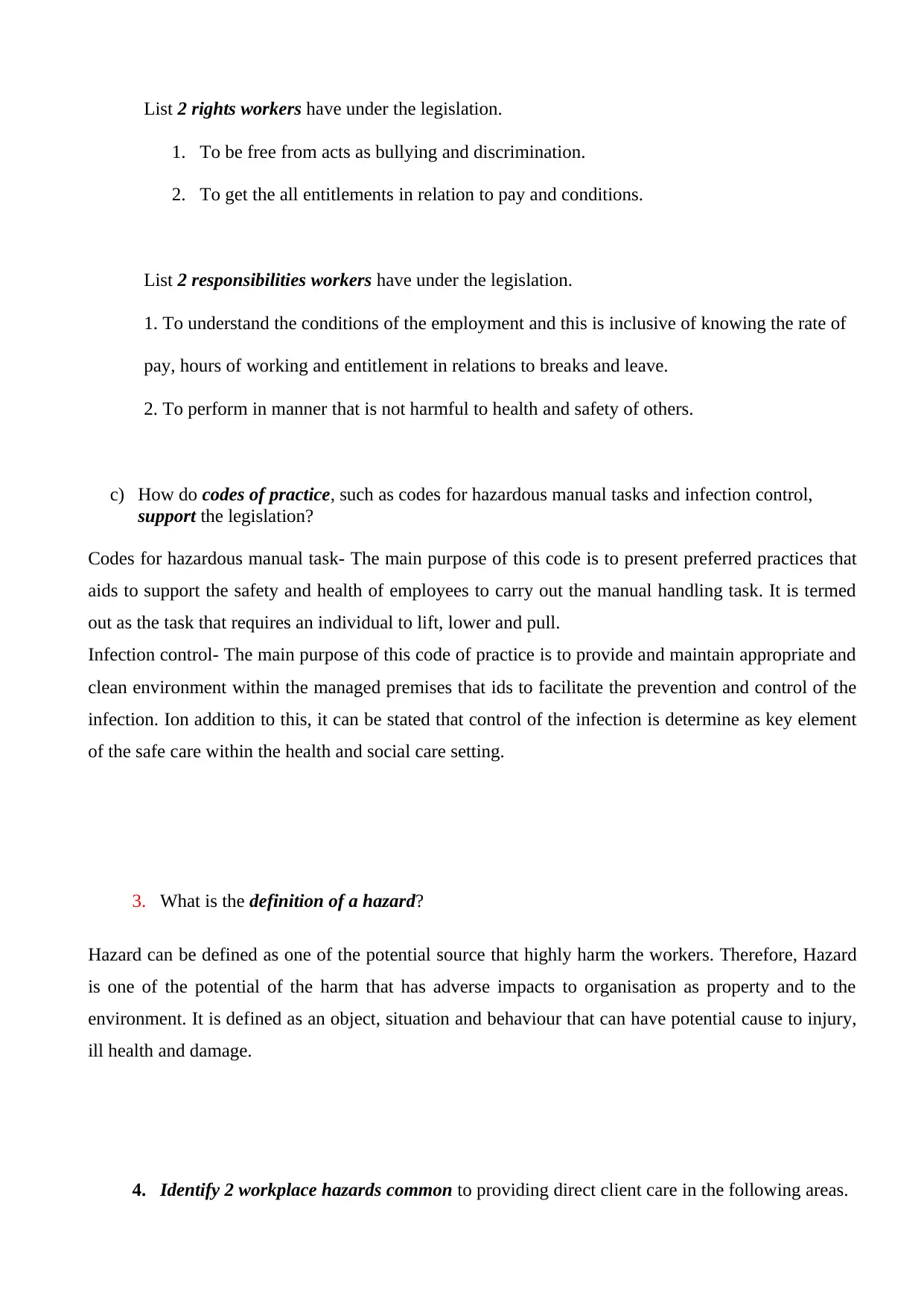
List 2 rights workers have under the legislation.
1. To be free from acts as bullying and discrimination.
2. To get the all entitlements in relation to pay and conditions.
List 2 responsibilities workers have under the legislation.
1. To understand the conditions of the employment and this is inclusive of knowing the rate of
pay, hours of working and entitlement in relations to breaks and leave.
2. To perform in manner that is not harmful to health and safety of others.
c) How do codes of practice, such as codes for hazardous manual tasks and infection control,
support the legislation?
Codes for hazardous manual task- The main purpose of this code is to present preferred practices that
aids to support the safety and health of employees to carry out the manual handling task. It is termed
out as the task that requires an individual to lift, lower and pull.
Infection control- The main purpose of this code of practice is to provide and maintain appropriate and
clean environment within the managed premises that ids to facilitate the prevention and control of the
infection. Ion addition to this, it can be stated that control of the infection is determine as key element
of the safe care within the health and social care setting.
3. What is the definition of a hazard?
Hazard can be defined as one of the potential source that highly harm the workers. Therefore, Hazard
is one of the potential of the harm that has adverse impacts to organisation as property and to the
environment. It is defined as an object, situation and behaviour that can have potential cause to injury,
ill health and damage.
4. Identify 2 workplace hazards common to providing direct client care in the following areas.
1. To be free from acts as bullying and discrimination.
2. To get the all entitlements in relation to pay and conditions.
List 2 responsibilities workers have under the legislation.
1. To understand the conditions of the employment and this is inclusive of knowing the rate of
pay, hours of working and entitlement in relations to breaks and leave.
2. To perform in manner that is not harmful to health and safety of others.
c) How do codes of practice, such as codes for hazardous manual tasks and infection control,
support the legislation?
Codes for hazardous manual task- The main purpose of this code is to present preferred practices that
aids to support the safety and health of employees to carry out the manual handling task. It is termed
out as the task that requires an individual to lift, lower and pull.
Infection control- The main purpose of this code of practice is to provide and maintain appropriate and
clean environment within the managed premises that ids to facilitate the prevention and control of the
infection. Ion addition to this, it can be stated that control of the infection is determine as key element
of the safe care within the health and social care setting.
3. What is the definition of a hazard?
Hazard can be defined as one of the potential source that highly harm the workers. Therefore, Hazard
is one of the potential of the harm that has adverse impacts to organisation as property and to the
environment. It is defined as an object, situation and behaviour that can have potential cause to injury,
ill health and damage.
4. Identify 2 workplace hazards common to providing direct client care in the following areas.
Paraphrase This Document
Need a fresh take? Get an instant paraphrase of this document with our AI Paraphraser
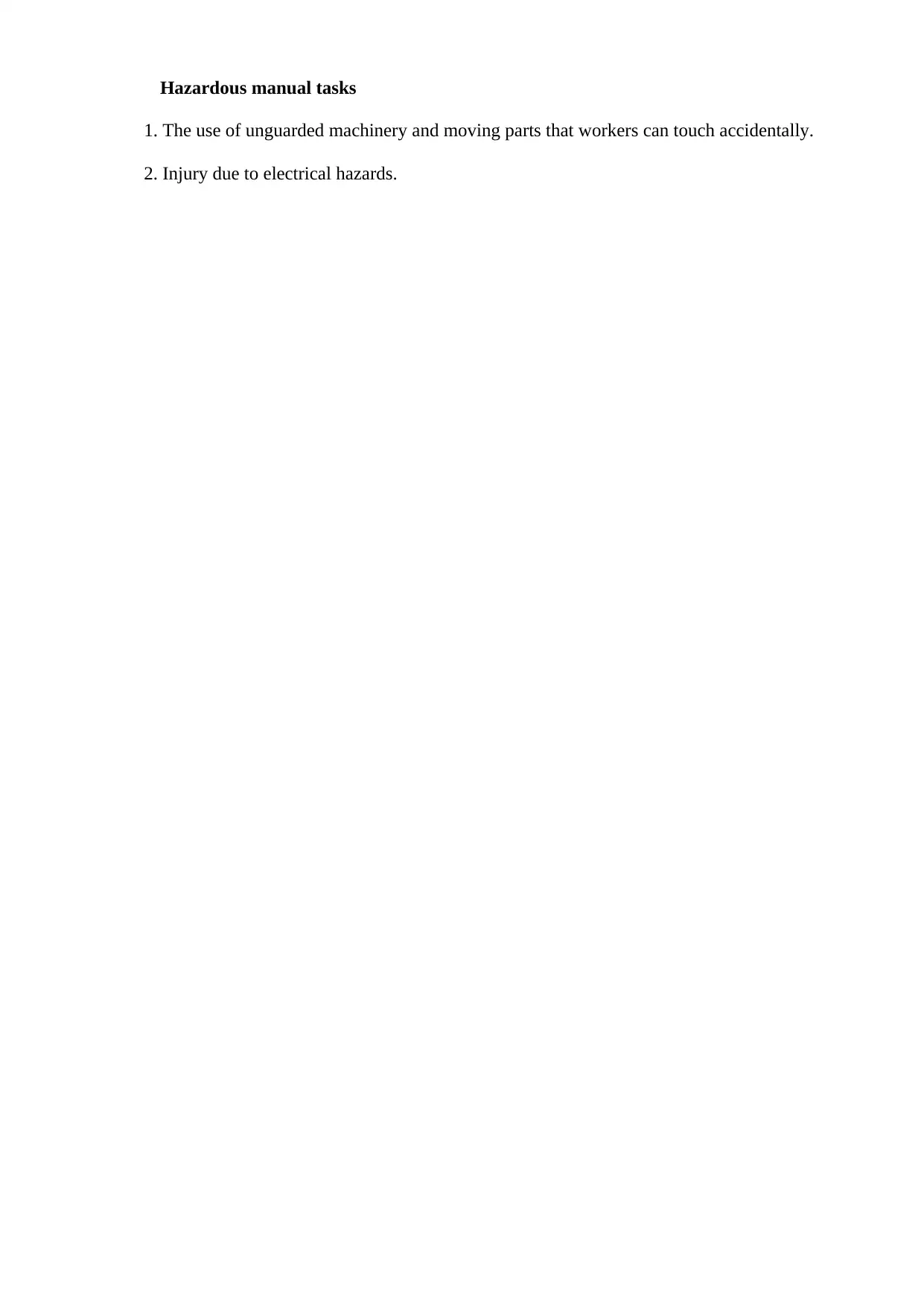
Hazardous manual tasks
1. The use of unguarded machinery and moving parts that workers can touch accidentally.
2. Injury due to electrical hazards.
1. The use of unguarded machinery and moving parts that workers can touch accidentally.
2. Injury due to electrical hazards.
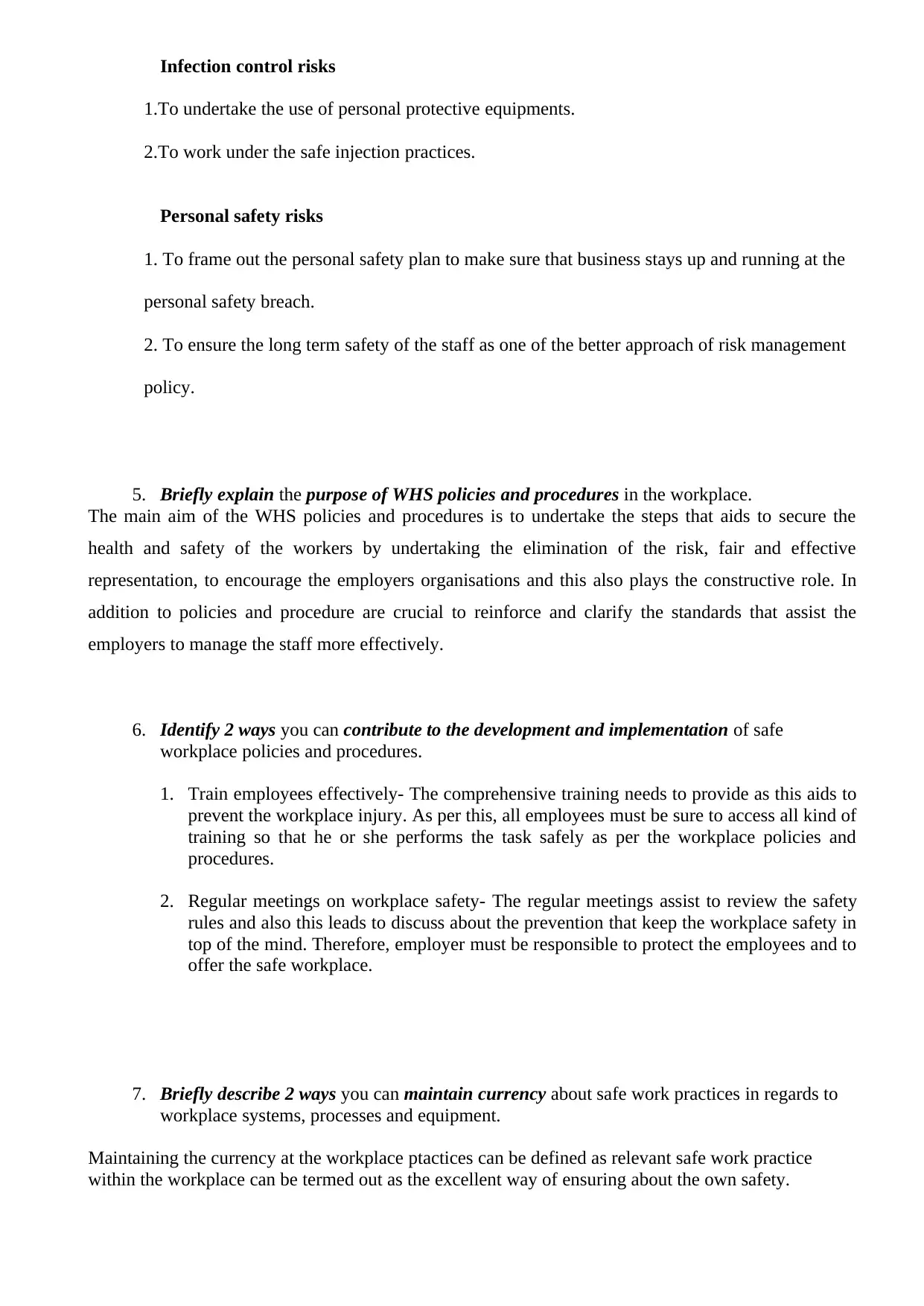
Infection control risks
1.To undertake the use of personal protective equipments.
2.To work under the safe injection practices.
Personal safety risks
1. To frame out the personal safety plan to make sure that business stays up and running at the
personal safety breach.
2. To ensure the long term safety of the staff as one of the better approach of risk management
policy.
5. Briefly explain the purpose of WHS policies and procedures in the workplace.
The main aim of the WHS policies and procedures is to undertake the steps that aids to secure the
health and safety of the workers by undertaking the elimination of the risk, fair and effective
representation, to encourage the employers organisations and this also plays the constructive role. In
addition to policies and procedure are crucial to reinforce and clarify the standards that assist the
employers to manage the staff more effectively.
6. Identify 2 ways you can contribute to the development and implementation of safe
workplace policies and procedures.
1. Train employees effectively- The comprehensive training needs to provide as this aids to
prevent the workplace injury. As per this, all employees must be sure to access all kind of
training so that he or she performs the task safely as per the workplace policies and
procedures.
2. Regular meetings on workplace safety- The regular meetings assist to review the safety
rules and also this leads to discuss about the prevention that keep the workplace safety in
top of the mind. Therefore, employer must be responsible to protect the employees and to
offer the safe workplace.
7. Briefly describe 2 ways you can maintain currency about safe work practices in regards to
workplace systems, processes and equipment.
Maintaining the currency at the workplace ptactices can be defined as relevant safe work practice
within the workplace can be termed out as the excellent way of ensuring about the own safety.
1.To undertake the use of personal protective equipments.
2.To work under the safe injection practices.
Personal safety risks
1. To frame out the personal safety plan to make sure that business stays up and running at the
personal safety breach.
2. To ensure the long term safety of the staff as one of the better approach of risk management
policy.
5. Briefly explain the purpose of WHS policies and procedures in the workplace.
The main aim of the WHS policies and procedures is to undertake the steps that aids to secure the
health and safety of the workers by undertaking the elimination of the risk, fair and effective
representation, to encourage the employers organisations and this also plays the constructive role. In
addition to policies and procedure are crucial to reinforce and clarify the standards that assist the
employers to manage the staff more effectively.
6. Identify 2 ways you can contribute to the development and implementation of safe
workplace policies and procedures.
1. Train employees effectively- The comprehensive training needs to provide as this aids to
prevent the workplace injury. As per this, all employees must be sure to access all kind of
training so that he or she performs the task safely as per the workplace policies and
procedures.
2. Regular meetings on workplace safety- The regular meetings assist to review the safety
rules and also this leads to discuss about the prevention that keep the workplace safety in
top of the mind. Therefore, employer must be responsible to protect the employees and to
offer the safe workplace.
7. Briefly describe 2 ways you can maintain currency about safe work practices in regards to
workplace systems, processes and equipment.
Maintaining the currency at the workplace ptactices can be defined as relevant safe work practice
within the workplace can be termed out as the excellent way of ensuring about the own safety.
⊘ This is a preview!⊘
Do you want full access?
Subscribe today to unlock all pages.

Trusted by 1+ million students worldwide

1. To take the measures to establish the active workplace safety and health safety committee.
2. To keep the employees informed about the safety inspection, illness, injury and other related
issues.
2. To keep the employees informed about the safety inspection, illness, injury and other related
issues.
Paraphrase This Document
Need a fresh take? Get an instant paraphrase of this document with our AI Paraphraser

8. Write the meaning for each safety sign in the table below.
Safety Sign Meaning of the sign
This is the sign that warn the people about the potential
hazards of the dangerous chemicals.
Danger sign are mainly for warning at the time hazard
and hazardous condition is not about the life
threatening.
This is sign that indicates that safety glover must be worn.
This is hand protection safety signs that can be visual reminder
of the need to use the personal protective equipments. It is
crucial to protect against the range of potential hazards to
hands.
This is sign of the portable electronic devise that automatically
diagnoses the life threatening cardiac ventricular fibrillation. It
is able to treat them with the help of de-fibrillation. This is one
of the tool that mainly used to help those individuals that is
experiencing the sudden cardiac arrest.
This is the sign that indicates the need of caution to avoid the
contamination with or undue exposure to atomic radiation.
Therefore, the wording on the signs varies with the level of
potential radiation in that particular area.
The community service environment highly use this signs and
this indicates about the specific hazards that may cause harm
to person if they do not take appropriate notice or action.
Henceforth, the main purpose of this symbole is to use those
infectious agents that presents the risk or the potential risk to
undertake the well being of the man.
Safety Sign Meaning of the sign
This is the sign that warn the people about the potential
hazards of the dangerous chemicals.
Danger sign are mainly for warning at the time hazard
and hazardous condition is not about the life
threatening.
This is sign that indicates that safety glover must be worn.
This is hand protection safety signs that can be visual reminder
of the need to use the personal protective equipments. It is
crucial to protect against the range of potential hazards to
hands.
This is sign of the portable electronic devise that automatically
diagnoses the life threatening cardiac ventricular fibrillation. It
is able to treat them with the help of de-fibrillation. This is one
of the tool that mainly used to help those individuals that is
experiencing the sudden cardiac arrest.
This is the sign that indicates the need of caution to avoid the
contamination with or undue exposure to atomic radiation.
Therefore, the wording on the signs varies with the level of
potential radiation in that particular area.
The community service environment highly use this signs and
this indicates about the specific hazards that may cause harm
to person if they do not take appropriate notice or action.
Henceforth, the main purpose of this symbole is to use those
infectious agents that presents the risk or the potential risk to
undertake the well being of the man.
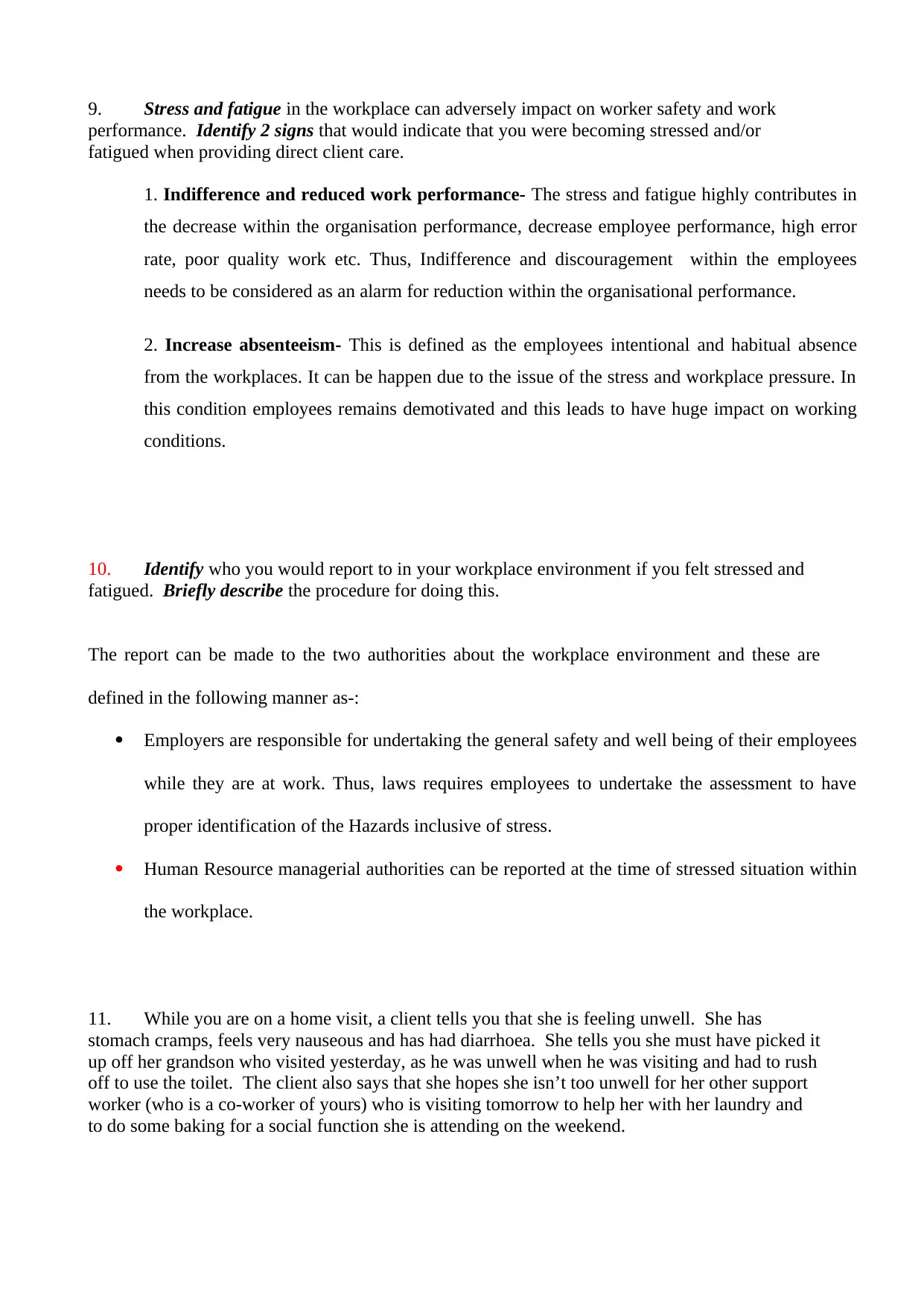
9. Stress and fatigue in the workplace can adversely impact on worker safety and work
performance. Identify 2 signs that would indicate that you were becoming stressed and/or
fatigued when providing direct client care.
1. Indifference and reduced work performance- The stress and fatigue highly contributes in
the decrease within the organisation performance, decrease employee performance, high error
rate, poor quality work etc. Thus, Indifference and discouragement within the employees
needs to be considered as an alarm for reduction within the organisational performance.
2. Increase absenteeism- This is defined as the employees intentional and habitual absence
from the workplaces. It can be happen due to the issue of the stress and workplace pressure. In
this condition employees remains demotivated and this leads to have huge impact on working
conditions.
10. Identify who you would report to in your workplace environment if you felt stressed and
fatigued. Briefly describe the procedure for doing this.
The report can be made to the two authorities about the workplace environment and these are
defined in the following manner as-:
Employers are responsible for undertaking the general safety and well being of their employees
while they are at work. Thus, laws requires employees to undertake the assessment to have
proper identification of the Hazards inclusive of stress.
Human Resource managerial authorities can be reported at the time of stressed situation within
the workplace.
11. While you are on a home visit, a client tells you that she is feeling unwell. She has
stomach cramps, feels very nauseous and has had diarrhoea. She tells you she must have picked it
up off her grandson who visited yesterday, as he was unwell when he was visiting and had to rush
off to use the toilet. The client also says that she hopes she isn’t too unwell for her other support
worker (who is a co-worker of yours) who is visiting tomorrow to help her with her laundry and
to do some baking for a social function she is attending on the weekend.
performance. Identify 2 signs that would indicate that you were becoming stressed and/or
fatigued when providing direct client care.
1. Indifference and reduced work performance- The stress and fatigue highly contributes in
the decrease within the organisation performance, decrease employee performance, high error
rate, poor quality work etc. Thus, Indifference and discouragement within the employees
needs to be considered as an alarm for reduction within the organisational performance.
2. Increase absenteeism- This is defined as the employees intentional and habitual absence
from the workplaces. It can be happen due to the issue of the stress and workplace pressure. In
this condition employees remains demotivated and this leads to have huge impact on working
conditions.
10. Identify who you would report to in your workplace environment if you felt stressed and
fatigued. Briefly describe the procedure for doing this.
The report can be made to the two authorities about the workplace environment and these are
defined in the following manner as-:
Employers are responsible for undertaking the general safety and well being of their employees
while they are at work. Thus, laws requires employees to undertake the assessment to have
proper identification of the Hazards inclusive of stress.
Human Resource managerial authorities can be reported at the time of stressed situation within
the workplace.
11. While you are on a home visit, a client tells you that she is feeling unwell. She has
stomach cramps, feels very nauseous and has had diarrhoea. She tells you she must have picked it
up off her grandson who visited yesterday, as he was unwell when he was visiting and had to rush
off to use the toilet. The client also says that she hopes she isn’t too unwell for her other support
worker (who is a co-worker of yours) who is visiting tomorrow to help her with her laundry and
to do some baking for a social function she is attending on the weekend.
⊘ This is a preview!⊘
Do you want full access?
Subscribe today to unlock all pages.

Trusted by 1+ million students worldwide

a) What is the source of infection in this Case Study?
The main source of infection to the client was spread of inflection. All of sudden she got unwell.
In the given case study, her grandson who visited yesterday as he was unwell at time as he has to
rush off to the toilet. Henceforth, spreading of the disease is the source of infection in this case
study.
b) How does this situation create a risk for you? Could anyone else be potentially affected
by this situation?
This is the situation that can be harmful. Thus, initiatives needs to be taken to cope up
with the issue as spreading of disease. At this kind of the situation, the proper care to the person
needs to be given. In this way, the another person can also get affected as she also became the part
of issue as infection.
The main source of infection to the client was spread of inflection. All of sudden she got unwell.
In the given case study, her grandson who visited yesterday as he was unwell at time as he has to
rush off to the toilet. Henceforth, spreading of the disease is the source of infection in this case
study.
b) How does this situation create a risk for you? Could anyone else be potentially affected
by this situation?
This is the situation that can be harmful. Thus, initiatives needs to be taken to cope up
with the issue as spreading of disease. At this kind of the situation, the proper care to the person
needs to be given. In this way, the another person can also get affected as she also became the part
of issue as infection.
Paraphrase This Document
Need a fresh take? Get an instant paraphrase of this document with our AI Paraphraser
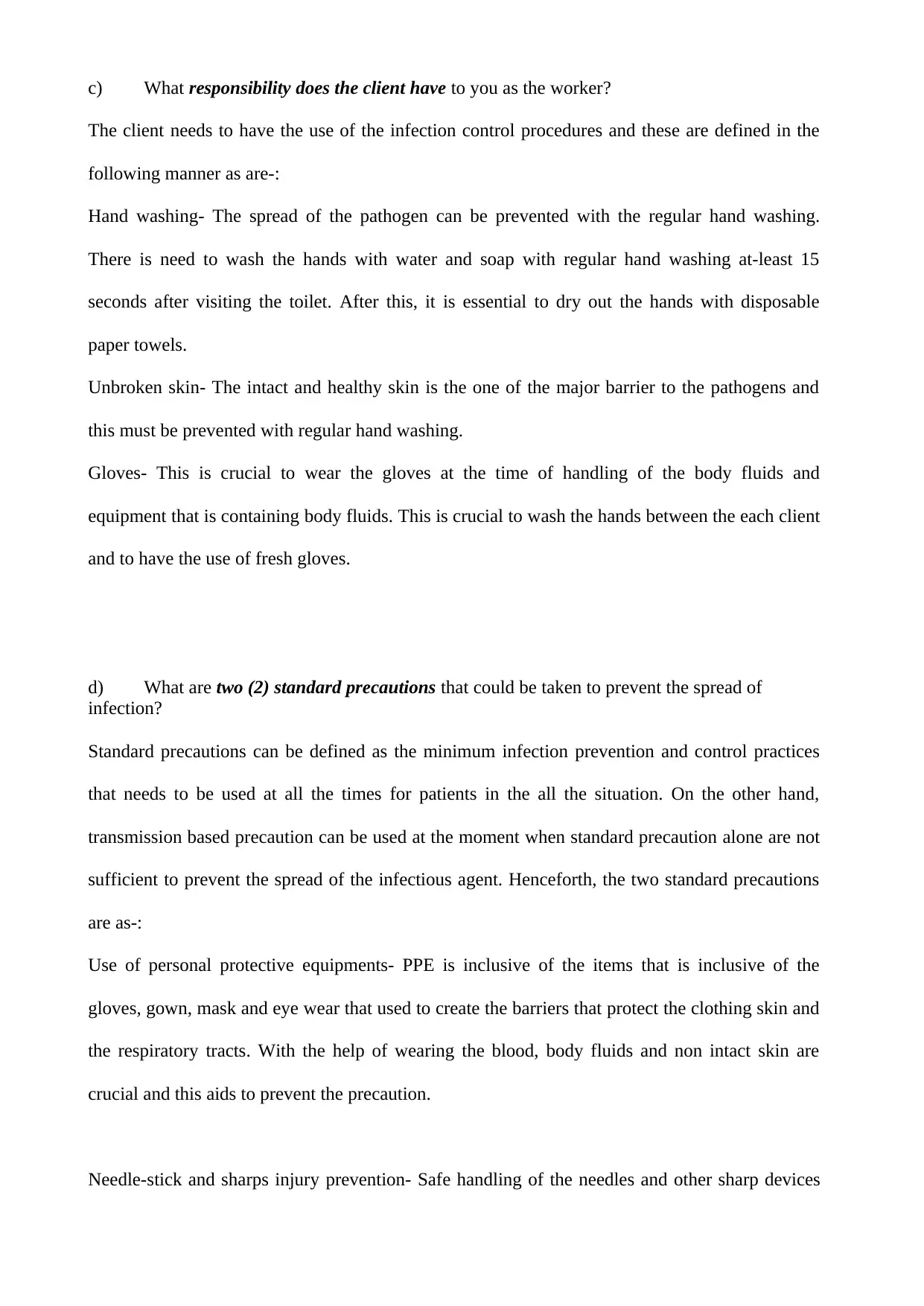
c) What responsibility does the client have to you as the worker?
The client needs to have the use of the infection control procedures and these are defined in the
following manner as are-:
Hand washing- The spread of the pathogen can be prevented with the regular hand washing.
There is need to wash the hands with water and soap with regular hand washing at-least 15
seconds after visiting the toilet. After this, it is essential to dry out the hands with disposable
paper towels.
Unbroken skin- The intact and healthy skin is the one of the major barrier to the pathogens and
this must be prevented with regular hand washing.
Gloves- This is crucial to wear the gloves at the time of handling of the body fluids and
equipment that is containing body fluids. This is crucial to wash the hands between the each client
and to have the use of fresh gloves.
d) What are two (2) standard precautions that could be taken to prevent the spread of
infection?
Standard precautions can be defined as the minimum infection prevention and control practices
that needs to be used at all the times for patients in the all the situation. On the other hand,
transmission based precaution can be used at the moment when standard precaution alone are not
sufficient to prevent the spread of the infectious agent. Henceforth, the two standard precautions
are as-:
Use of personal protective equipments- PPE is inclusive of the items that is inclusive of the
gloves, gown, mask and eye wear that used to create the barriers that protect the clothing skin and
the respiratory tracts. With the help of wearing the blood, body fluids and non intact skin are
crucial and this aids to prevent the precaution.
Needle-stick and sharps injury prevention- Safe handling of the needles and other sharp devices
The client needs to have the use of the infection control procedures and these are defined in the
following manner as are-:
Hand washing- The spread of the pathogen can be prevented with the regular hand washing.
There is need to wash the hands with water and soap with regular hand washing at-least 15
seconds after visiting the toilet. After this, it is essential to dry out the hands with disposable
paper towels.
Unbroken skin- The intact and healthy skin is the one of the major barrier to the pathogens and
this must be prevented with regular hand washing.
Gloves- This is crucial to wear the gloves at the time of handling of the body fluids and
equipment that is containing body fluids. This is crucial to wash the hands between the each client
and to have the use of fresh gloves.
d) What are two (2) standard precautions that could be taken to prevent the spread of
infection?
Standard precautions can be defined as the minimum infection prevention and control practices
that needs to be used at all the times for patients in the all the situation. On the other hand,
transmission based precaution can be used at the moment when standard precaution alone are not
sufficient to prevent the spread of the infectious agent. Henceforth, the two standard precautions
are as-:
Use of personal protective equipments- PPE is inclusive of the items that is inclusive of the
gloves, gown, mask and eye wear that used to create the barriers that protect the clothing skin and
the respiratory tracts. With the help of wearing the blood, body fluids and non intact skin are
crucial and this aids to prevent the precaution.
Needle-stick and sharps injury prevention- Safe handling of the needles and other sharp devices
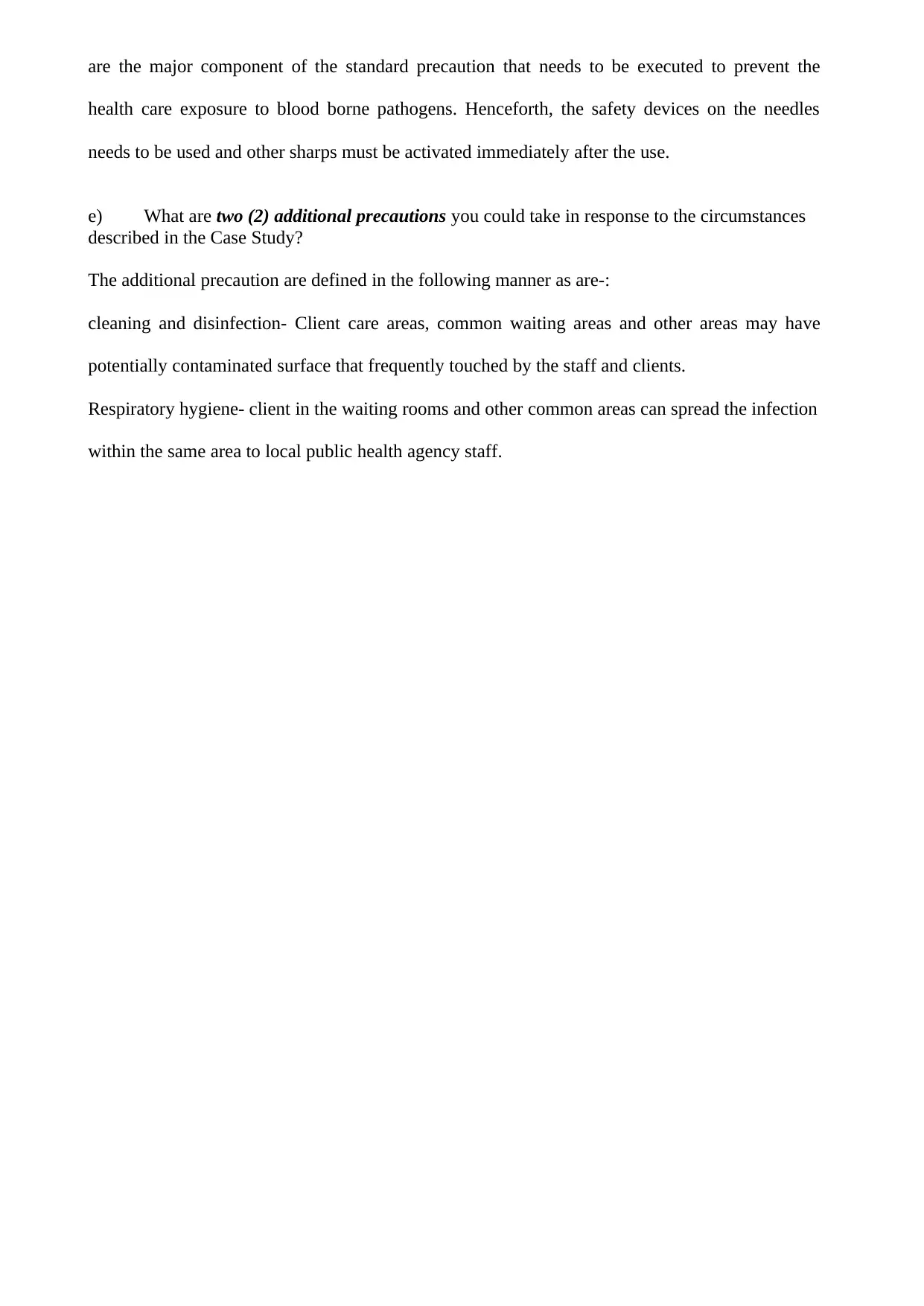
are the major component of the standard precaution that needs to be executed to prevent the
health care exposure to blood borne pathogens. Henceforth, the safety devices on the needles
needs to be used and other sharps must be activated immediately after the use.
e) What are two (2) additional precautions you could take in response to the circumstances
described in the Case Study?
The additional precaution are defined in the following manner as are-:
cleaning and disinfection- Client care areas, common waiting areas and other areas may have
potentially contaminated surface that frequently touched by the staff and clients.
Respiratory hygiene- client in the waiting rooms and other common areas can spread the infection
within the same area to local public health agency staff.
health care exposure to blood borne pathogens. Henceforth, the safety devices on the needles
needs to be used and other sharps must be activated immediately after the use.
e) What are two (2) additional precautions you could take in response to the circumstances
described in the Case Study?
The additional precaution are defined in the following manner as are-:
cleaning and disinfection- Client care areas, common waiting areas and other areas may have
potentially contaminated surface that frequently touched by the staff and clients.
Respiratory hygiene- client in the waiting rooms and other common areas can spread the infection
within the same area to local public health agency staff.
⊘ This is a preview!⊘
Do you want full access?
Subscribe today to unlock all pages.

Trusted by 1+ million students worldwide
1 out of 21
Related Documents
Your All-in-One AI-Powered Toolkit for Academic Success.
+13062052269
info@desklib.com
Available 24*7 on WhatsApp / Email
![[object Object]](/_next/static/media/star-bottom.7253800d.svg)
Unlock your academic potential
Copyright © 2020–2025 A2Z Services. All Rights Reserved. Developed and managed by ZUCOL.




